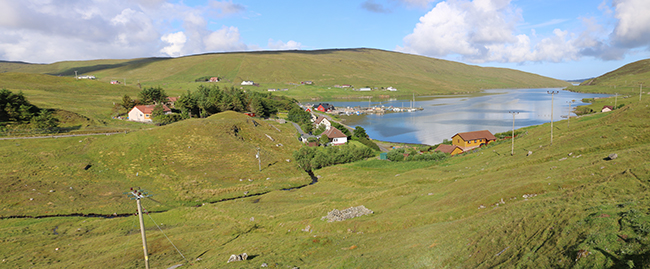Here’s the answer to the contest:

This is an outcrop on the beach at Funzie Bay, Fetlar, Shetland, U.K.
The modern beach sediment is the lightest-colored, rounded cobbles at both the top and bottom of the photo. Poking out in between is a layer of light-gray colluvium (angular fragments) overlain by dark peat, now perhaps approaching lignite. Because peat in Shetland cloaks the hillsides but is unlikely to grow a couple meters above sea level where the pounding waves of winter storms can reach, this combination suggests a lower sea level for Shetland at some point in the past. In other words, the modern beach deposits overlap older hillside deposits.
And the implication is that sea level was lower in the past.
Another line of evidence for this is geomorphic: all over Shetland, you’ll find voes, like this one:
A voe is a local term (Shetland + Orkney) for an ocean-flooded valley. So a fjord (ocean-flooded glacial valley) would be a special kind of voe. But most of Shetland’s voes are fluvial rather than glacial in origin. [I suppose, by this definition, the Chesapeake Bay could be considered a voe, since that estuary was formed as sea level rose and flooded the former valley of the Susquehanna River.]
Anyhow, look at Shetland! Explore it in this embedded Google Map – you’ll see all sorts of skinny little coves reaching in from the sea like the tentacles of a cephalopod. Almost all of these are voes, though there’s at least one fjord among them, too.
Streams only cut valleys if they’re flowing downhill (i.e., toward the sea), which means that all these places that are today below sea level used to be above it.
Thanks to those who participated in the contest. Among them, Simon Wellings and Bill Burton came closest to the mark – got it right, even, though I used it as a springboard to this sea level discussion.

